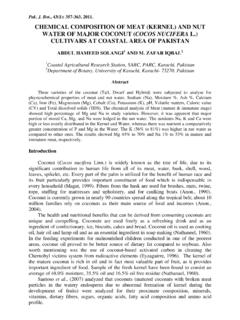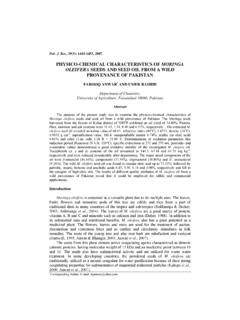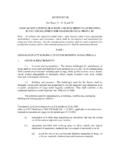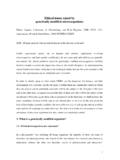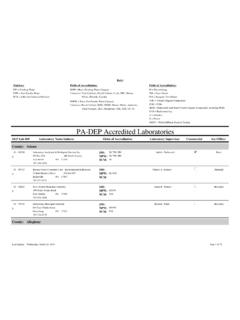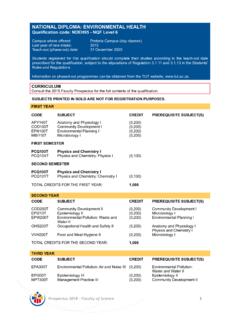Transcription of EFFECT OF HEAVY METALS ON SOIL MICROBIAL …
1 Pak. J. Bot., 39(2): 629-636, 2007. EFFECT OF HEAVY METALS ON soil MICROBIAL community AND mung BEANS SEED GERMINATION RABIA ASHRAF AND TASNEEM ADAM ALI Department of microbiology , University of Karachi; Karachi 75270, Pakistan. Abstract Pollution of the biosphere by HEAVY METALS has caught our attention in finding new ways to sustain, restore and manage the environment. In this context, the study was carried out to assess and determine the cumulative EFFECT of HEAVY METALS on soil microorganisms and seed germination, which ultimately contribute serious threats to the ecosystem. We attempted to isolate stress tolerant bacteria and fungi from the soil amended with varying concentrations of HEAVY metal salts including silver (Ag), zinc (Zn) and lead (Pb).
2 The procedure describes the selection of HEAVY metal salts, characterization of soil , simulated pollution of soil , isolation, identification, characterization, screening and assessment of HEAVY metal tolerance by bacteria and fungi. Effects of varying concentrations of HEAVY METALS on the germination of seeds (bioassay) were also taken into consideration. The data suggested that lead and silver were found to be toxic for the growth of microorganisms. The amendment of zinc in the soil up to 50mM concentration facilitated the growth of bacteria and fungi. An overall change in the MICROBIAL communities was observed in comparision with the control.
3 Germination of seeds was favoured with increasing concentrations of zinc (50mM), which indicated the essentiality of zinc to plants. More deleterious effects on the germination of Vigna radiata ( mung beans) were observed in case of silver, while moderate toxicity was observed in case of lead. Silver was found to be extremely toxic since the minimum concentration (10mM) resulted in the complete inhibition of seed germination. The seed germination in the presence of 10 and 25 mM concentration of silver was delayed for a period of 10 days but subsequent exposure to same concentration for 15 days resulted in the germination of seeds.
4 Introduction The quality of life on earth is linked undeniably to the overall quality of the environment (Anon., 1995). Pollution of the biosphere by HEAVY METALS due to industrial, agricultural and domestic activities has created a serious problem for the safe and rational utilization of soils (Srivastava et al., 2005; Avery, 2001; Igwe et al., 2005; Kandori et al., 1993; Volesky, 1990). Industrial inputs and the agronomic application of fertilizers, pesticides and metal - contaminated sewage continue to contribute the metal accumulation in the soil (Herland et al., 2000). The pollution of the ecosystem by HEAVY METALS is a real threat to the environment because METALS cannot be naturally degraded like organic pollutants and persist in the ecosystem having accumulated in different parts of the food chain ((Igwe et al.))
5 , 2005; Smejkalova et al., 2003). metal toxicity may affect all forms of life including microorganisms, plants and animals, but the degree of toxicity varies for different organisms. Physical, chemical and biological processes may combine under certain circumstances to concentrate METALS rather than dilute them (Igwe et al., 2005). Several researchers using isolation-based techniques have demonstrated that HEAVY metal contamination can cause shifts in MICROBIAL populations (Barkay et al., 1985; Doelman et al., 1994; Gringell et al., 1976; Roane & Kellogg, 1996). The immediate toxicity of RABIA ASHRAF & TASNEEM ADAM ALI 630metals to soil organisms is moderated by metal immobilization by soil colloidal components however, HEAVY METALS may be mobilized by local and global changes in soil conditions , changes in physical and chemical conditions of soil environment, including decrease in pH, redox potential and enhanced decomposition of organic matter (Gupta, 1992, Hattori, 1996; Kelly et al.
6 , 2003). HEAVY METALS exert toxic effects on soil microorganism (Pawlowska & Charvat, 2004) hence results in the change of the diversity, population size and overall activity of the soil MICROBIAL communities (Smejkalova et al., 2003; Gupta, 1992; Hattori, 1996; Kelly et al., 2003). Gasper et al., (2005) reported that the after- EFFECT of the observed HEAVY metal (Cr, Zn and Cd) pollution influenced the metabolism of soil microbes in all cases. In general, an increase of metal concentration adversely affects soil MICROBIAL properties respiration rate, enzyme activity, which appears to be very useful indicators of soil pollutions (Brookes, 1995; Szili-Kovacs et al.
7 , 1999). Microorganisms, including bacteria, algae, fungi and yeast, serve as very constructive models for studying the harmful effects of METALS at the cellular level (Avery, 2001). These microorganisms can also be used to remove toxic- METALS from contaminated sites as they can efficiently accumulate HEAVY METALS and radionuclides from their external environment (Ali & Wainwright, 1995). In the present study, effects of different HEAVY METALS on the diversity and extent of soil microorganisms have been determined. The effects of metal toxicity on the germination of mung bean seeds were used as a model in this study, since seeds are well protected against various stresses which soon after imbibitions and subsequent vegetative developmental processes, become stress-sensitive in general (Weiqianjgli et al.
8 , 2005). Materials and Methods METALS used in this study included lead sulphate (Pb SO4) and lead acetate (Pb (CH3 COO) ) , silver nitrate (Ag NO3), zinc sulphate (ZnSO4). Garden soil was collected from the Department of microbiology , University of Karachi. Physicochemical characteristics of the soil colour, structure, pH, organic matter, electric conductivity (ECe), water holding capacity (WHC) and moisture content were determined using the methods described by Gupta, (2004). The soil was filled into clay pots (200g/ pot) and was amended with different concentrations (10, 25 and 50 mM) of these metal salts.
9 Controls were run side by side without any metal amendment. All the tests and controls were run in triplicate. Rossi & Cholodney s buried slide technique was performed to determine the EFFECT of HEAVY METALS on microorganisms in their native environment (Alexander, 1961; Waksman, 1957). Isolation was carried out after 15 days of incubation and standard plate count (SPC) was performed as given by Pelczar et al., (2003). Ten-fold serial dilutions were made up to 10-6. An amount of ml from the diluted samples (dilution10-4 for fungi and 10-6 for bacteria) was spread on the respective culture media plates using a glass spreader.
10 These plates were then incubated at ambient temperature for 24 h for bacteria and 4-5 days for fungi. soil extract agar (pH 7) was used for bacteria, colonies were counted and CFU/g was calculated for bacteria. soil extract agar (pH 5), Potato dextrose agar (pH ) and Malt agar (pH ) were used for the isolation of fungi. The isolates were maintained on respective media slants and were identified (Barnett & Hunter, 1998; Barnett, 1960; Thom & Raper, 1945). The isolates were inoculated into soil extract broth (pH 7 and pH5) with glucose amended with HEAVY metal for the EFFECT OF HEAVY METALS ON soil MICROBIAL community 631 assessment of HEAVY metal tolerance.

